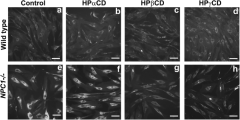Niemann–Pick type C (NPC) disease is a fatal hereditary neurodegenerative disorder characterized by a massive accumulation of cholesterol in lysosomes and late endosomes due to a defect in intracellular cholesterol trafficking. Dysfunction in intracellular cholesterol trafficking is responsible for about 50 rare inherited lysosomal storage disorders including NPC. The lysosomal proteins NPC1 and NPC2 play a crucial role in trafficking of cholesterol from late endosomes and lysosomes to other cellular compartments. However, the detailed mechanisms of cholesterol trafficking at the late endosomes/lysosomes (LE/LY) are poorly understood. Studies showed that 2-hydroxypropyl-β-cyclodextrin (HPβCD) alleviates the cholesterol accumulation defect in animal model and has been approved for a phase 2b/3 clinical trial for NPC. HPβCD is known to bind cholesterol; however, the mechanisms how HPβCD mediates the exit of cholesterol from the LE/LY compartments are still unknown. Further, another cyclodextrin (CD) derivative, 2-hydroxypropyl-γ-cyclodextrin (HPγCD), was shown to reduce intracellular cholesterol accumulation in NPC patient cells and NPC mice model. Herein, we identified a number of candidate proteins differentially expressed in NPC patient-derived cells compared to cells derived from a healthy donor using a proteomic approach. Interestingly, both HPβCD and HPγCD treatments modulated the expression of most of these NPC-specific proteins. Data showed that treatment with both CDs induces the expression of the lysosome-associated membrane protein 1 (LAMP-1) in NPC patient-derived cells. Remarkably, LAMP-1 overexpression in HeLa cells rescued U18666A-induced cholesterol accumulation suggesting a role of LAMP-1 in cholesterol trafficking. We propose that HPβCD and HPγCD facilitate cholesterol export from the LE/LY compartments via the LAMP-1 protein, which may play a crucial role in cholesterol trafficking at the LE/LY compartments when there is no functional NPC1 protein. Together, this study uncovers new cellular mechanisms for cholesterol trafficking, which will contribute to development of novel therapeutic approaches for lysosomal storage diseases.


